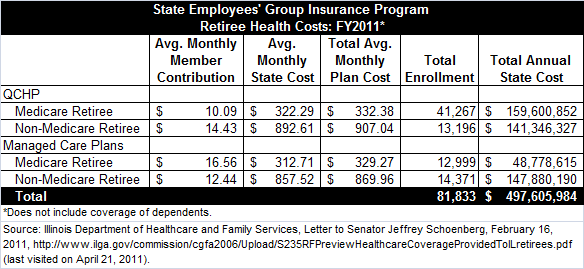April 21, 2011
Governor Pat Quinn’s recommended FY2012 budget for the State of Illinois proposes that General Funds appropriations for the State Employees’ Group Insurance Program more than double to $1.4 billion from $695.8 million in FY2011.[1] This proposal, which reflects significant underfunding of the program in FY2011, has drawn more attention to how much the State pays for employee and retiree healthcare.[2]
The State Employees’ Group Insurance Program provides medical, dental, vision and life insurance coverage for employees of the state government, state universities, the General Assembly and the judiciary and for their retirees and dependents. The program offers an indemnity plan called Quality Care Health Plan (QCHP), in which participants are permitted to choose any physician or hospital.[3] The program also offers various managed care plans such as health maintenance organizations (HMOs), in which choices are more restricted.
The group insurance program had an estimated 351,566 participants in FY2011, of which 33.8% were in the QCHP and 66.2% were in managed care plans, according to the Illinois General Assembly’s Commission on Government Forecasting and Accountability (COGFA). Membership in the QCHP has been declining since FY2005, while membership in managed care plans has been increasing since FY2004.
The average annual cost per participant varies by type of plan chosen and whether Medicare is the primary insurer. In FY2011, the average annual premium cost per participant is estimated at $6,399 in the QCHP plan and $5,567 in managed care. The State is expected to pay on average $5,596 a year for a QCHP participant and $4,913 for a managed care participant.
In FY2011, 66.6% of retirees chose QCHP, compared to less than 30% of employees and dependents. More than 70% of employees and dependents favored the managed care plans.
State employees who retired before January 1, 1998 and those who retired after that date with at least 20 years of service do not pay healthcare premiums.[4] Exceptions include General Assembly members, who can retire with as little as four years of service and not have to pay premiums, and judges, who can retire with as little as six years of service and not pay premiums.
As of February 2011, 91.0% of the 81,833 retirees covered by the group insurance program were not required to pay any premiums. The State is expected to pay $497.6 million for health insurance coverage for retirees in FY2011, while retirees are expected to pay $12.0 million.
The table below shows average monthly retiree health costs for members and for the State in FY2011 and total state costs. These figures do not include the cost of coverage for retirees’ dependents; retirees are required to pay premiums for their dependents.

On February 9, 2011, COGFA members voted to hire a consulting firm to study the cost of retiree healthcare provided by the State. The study will review what other states charge for retiree coverage and will present recommendations for a possible new premium structure for Illinois in which all retirees make contributions based on their overall household income. The study is due to be completed by May 2, 2011, in time for legislative proposals to be enacted before the General Assembly adjourns at the end of May.
Julie Hamos, Director of the Illinois Department of Healthcare and Family Services (HFS), testified at the COGFA meeting on February 9 that Governor Pat Quinn did not foresee any changes to the existing retiree health program until after collective bargaining agreements expire at the end of FY2012. Council 31 of the American Federation of State, County and Municipal Employees (AFSCME) has taken the position that any proposed changes in retiree healthcare benefits must be negotiated with the union.
However, Ms. Hamos also stated that HFS could propose new rules requiring retired General Assembly members and judges to pay healthcare premiums but has not done so. Currently, there are 1,343 retirees in the General Assembly and judges’ plans with total estimated health insurance costs of $8.45 million in FY2011.[5]
For more information on state employee and retiree health insurance, see the Civic Federation’s 2007 report State of Illinois Employee Health Insurance Plans: Analysis and Recommendations for Cost Containment.
